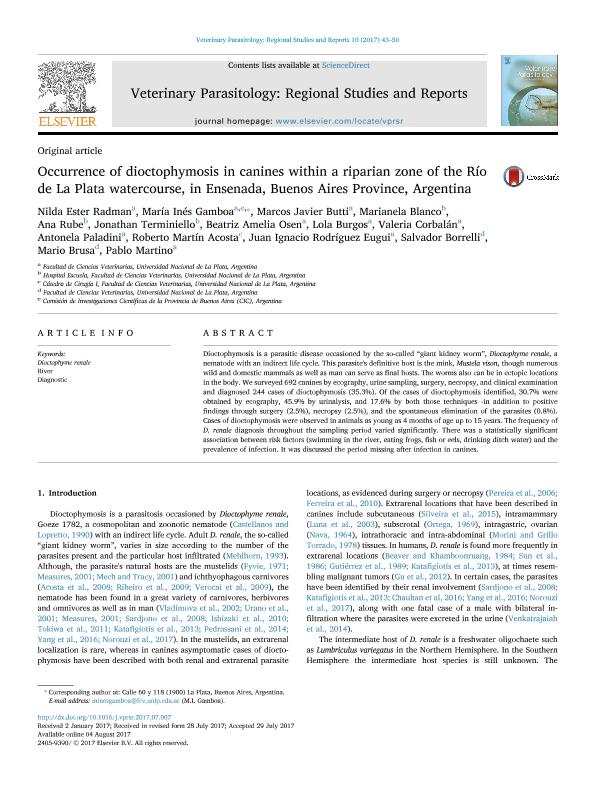Artículo
Occurrence of dioctophymosis in canines within a riparian zone of the Río de La Plata watercourse, in Ensenada, Buenos Aires Province, Argentina
Radman, Nilda Ester; Gamboa, María Inés; Butti, Marcos Javier; Blanco, Marianela Cristina; Rube, Ana Maria; Terminiello, Jonathan; Osen, Beatriz Amelia; Burgos, Lola; Corbalán, Valeria Vanesa ; Paladini, Antonela; Acosta, Roberto Martín; Rodríguez Eugui, Juan Ignacio; Borrelli, Salvador Osvaldo; Brusa, Mario César; Martino, Pablo
; Paladini, Antonela; Acosta, Roberto Martín; Rodríguez Eugui, Juan Ignacio; Borrelli, Salvador Osvaldo; Brusa, Mario César; Martino, Pablo
 ; Paladini, Antonela; Acosta, Roberto Martín; Rodríguez Eugui, Juan Ignacio; Borrelli, Salvador Osvaldo; Brusa, Mario César; Martino, Pablo
; Paladini, Antonela; Acosta, Roberto Martín; Rodríguez Eugui, Juan Ignacio; Borrelli, Salvador Osvaldo; Brusa, Mario César; Martino, Pablo
Fecha de publicación:
12/2017
Editorial:
Elsevier Science
Revista:
Veterinary Parasitology: Regional Studies and Reports
ISSN:
2405-9390
Idioma:
Inglés
Tipo de recurso:
Artículo publicado
Clasificación temática:
Resumen
Dioctophymosis is a parasitic disease occasioned by the so-called “giant kidney worm”, Dioctophyme renale, a nematode with an indirect life cycle. This parasite's definitive host is the mink, Mustela vison, though numerous wild and domestic mammals as well as man can serve as final hosts. The worms also can be in ectopic locations in the body. We surveyed 692 canines by ecography, urine sampling, surgery, necropsy, and clinical examination and diagnosed 244 cases of dioctophymosis (35.3%). Of the cases of dioctophymosis identified, 30.7% were obtained by ecography, 45.9% by urinalysis, and 17.6% by both those techniques -in addition to positive findings through surgery (2.5%), necropsy (2.5%), and the spontaneous elimination of the parasites (0.8%). Cases of dioctophymosis were observed in animals as young as 4 months of age up to 15 years. The frequency of D. renale diagnosis throughout the sampling period varied significantly. There was a statistically significant association between risk factors (swimming in the river, eating frogs, fish or eels, drinking ditch water) and the prevalence of infection. It was discussed the period missing after infection in canines.
Palabras clave:
Diagnostic
,
Dioctophyme Renale
,
River
Archivos asociados
Licencia
Identificadores
Colecciones
Articulos(CEPAVE)
Articulos de CENTRO DE EST.PARASITOL.Y DE VECTORES (I)
Articulos de CENTRO DE EST.PARASITOL.Y DE VECTORES (I)
Citación
Radman, Nilda Ester; Gamboa, María Inés; Butti, Marcos Javier; Blanco, Marianela Cristina; Rube, Ana Maria; et al.; Occurrence of dioctophymosis in canines within a riparian zone of the Río de La Plata watercourse, in Ensenada, Buenos Aires Province, Argentina; Elsevier Science; Veterinary Parasitology: Regional Studies and Reports; 10; 12-2017; 43-50
Compartir
Altmétricas



